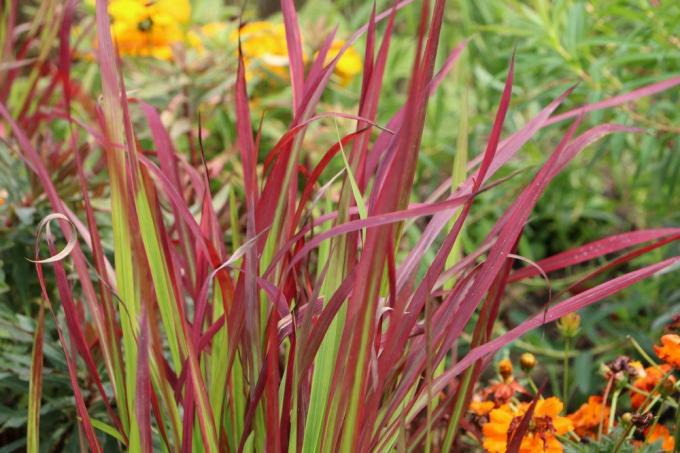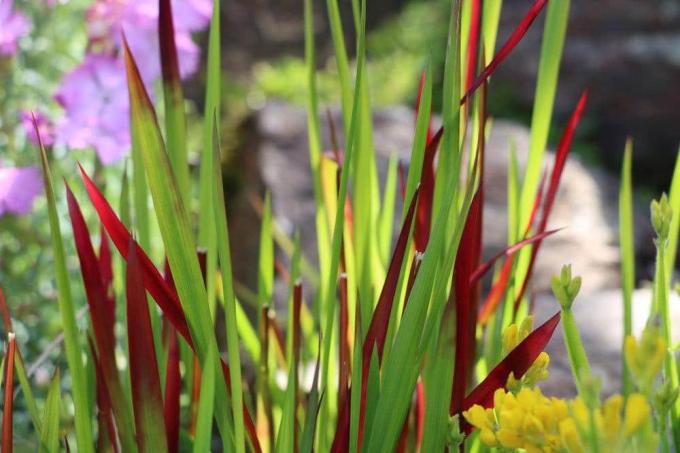
table of contents
- Cutting Japanese blood grass
- The best time to cut back
- Instructions for cutting
- Caution: razor-sharp leaf margins
- How hardy is the Japanese blood grass?
- Winter in the garden
- In the bucket
The Japanese blood grass is a cultivated form of the much larger silver hair grass. It is particularly popular because of its high-contrast, blood-red leaves, from which it owes its name. When it shoots, the leaves are still green and turn increasingly bright red towards summer. This color becomes even more intense in autumn. In order to be able to enjoy this splendor year after year, this ornamental grass should be cut back as regularly as possible and properly overwintered.
Cutting Japanese blood grass
The Japanese blood grass belongs to the perennial shrubs. In contrast to the silver hair grass, the trunk form, it only reaches heights of between 30 and 40 cm, depending on the location and the nature of the soil. The extremely decorative blood-red coloring of the leaves, which the perennial only shows
full sun Locations can last into winter in mild weather and in sheltered locations. This of course assumes that they are not pruned back in autumn.The best time to cut back
So that the Japanese bloodgrass can still impress with its splendid coloration in winter, it is important to wait for the right time for the cut.
- Always wait until spring before pruning ornamental grasses
- Cutting not recommended in autumn
- The beautiful look is of secondary importance
- The main reason for cutting in spring is to protect the grass from frost
- Leaves or Stalks serve as natural winter protection for the ornamental grass
- Protects the inside of the plant from frost, moisture and rot
- Narrow blades of grass direct rainwater away from the plant to the side
- Cut in autumn, would expose root area
- Moisture could penetrate unhindered
- The result would be rot in the root area
Another, no less important reason for a pruning in spring is that the leaves serve numerous insects as shelter and winter quarters during the cold season.
These are all good and important reasons to cut back on that spring to be relocated, ideally to mid-February or early March. As a rule, you should cut before the new shoot can be seen, but at the latest with the shoot.
Missed the right time to cut?
If you wait too long with the pruning of the bloodgrass and the new shoot is already in full swing, maybe because of the If new shoots have started unusually early, there is a risk that precisely these new shoots will be damaged when pruning respectively. be cut off. This in turn results in weaker growth and unsightly brown edges at the interfaces. Otherwise, a lack of pruning does not affect the plant.
Instructions for cutting
If you want to rejuvenate these plants, you cannot achieve this with an appropriate cut. To do this, it has to be excavated and divided in the conventional way. If you have now timed the pruning, there is actually not much to consider.
- Cut blood grass 'Imperata cylindrica' back to two hand widths above the ground
- About 10-15 cm should remain
- Gather the leaves in bunches and cut them off
- Be sure to wear gloves when cutting
- Leaves of this ornamental grass are very sharp-edged
- Do not make the cut too deep under any circumstances
- This could damage new shoots and the green core
- If new shoots are visible, cut just above it
- Sections should be as smooth as possible
- The stalks of the bloodgrass are sometimes very firm
- Very sharp cutting tools are indispensable
If the new shoots are already too far, it is advisable to forego pruning this year and only comb out the perennial and pluck out brown stalks. In this way, at least dead and unsightly parts of the plant can be removed. You run your fingers, of course not without gloves, or with a rake through the grass several times. Combing out not only has optical advantages, it also ensures that sufficient light gets inside the plant and that the whole thing is well ventilated all around.

tip: Immediately after pruning is the best time to fertilize this perennial with compost or a slow release fertilizer. The nutrients contained in the fertilizer are required for new growth and for healthy and lush growth.
Caution: razor-sharp leaf margins
When handling this plant, the razor-sharp stalks can quickly lead to cuts. These sharp stalks result from the inclusion of sharp-edged silicate crystals, which is why grasses of the species Imperata cylindrica are also known as sword grass in English. To protect yourself from injury, you should work on and with this plant Protective gloves and wear long-sleeved outerwear. If necessary, eye protection in the form of protective goggles can also be useful.
How hardy is the Japanese blood grass?
In well-protected locations and in very mild winters, 'Imperata cylindrica' retains its blood-red stalks into winter, and in exceptional cases even into spring. However, the Japanese bloodgrass does not develop flowers in our latitudes. In most regions of Germany, this plant, which is one of the sweet grasses, is only conditionalhardy. Especially in the first few years after planting, it is grateful for appropriate frost protection, especially in regions with very harsh winters. To what extent depends on whether the bloodgrass is cultivated in the garden or in the tub.
Winter in the garden
The most important protection against winter cold and moisture are the leaves of this ornamental grass themselves. It is for this very reason that they should only be cut back in spring. To protect the heart, the stalks are loosely tied together with a cord made of natural fibers, for example sisal. Rainwater can also run off this well and not cause rot inside the plant. A layer of dry leaves, straw or fir twigs is usually sufficient to cover the root area.
If a very cold winter is looming, as soon as the temperatures remain permanently below freezing point, the ornamental grass can also be heaped up with dry pine bark. cover. However, you should not do this too early, because then the grass could turn brown and rot. This in turn makes wintering more difficult and can endanger the survival of the plant. As far as maintenance is concerned during the winter, fertilizers are completely dispensed with and moderately poured on frost-free days. In the spring, the protection must be removed again in good time.
tip: Transplanting in autumn or from a bed in a pot is not advisable, because then a safe wintering is not guaranteed. The situation is different for specimens that are planted in planters from the start and cultivated there permanently.
In the bucket
In the bucket this ornamental grass is generally more sensitive to frost and therefore more sensitive to frost not hardy. Container plants are generally more sensitive and need to be protected even better. The risk that the root ball will freeze completely due to the small volume of soil is particularly high here. Even the strongest and healthiest plant would not recover from that. A good one is all the more important Frost protection. Even if the bloodgrass in the planter is not sufficiently hardy, it is also possible to overwinter outdoors under certain circumstances.
- Safe wintering of 'Imperata cylindrica', protected and frost-free
- Also outdoors in less cold locations
- Place the planter in a protected location
- Ideally in front of a south-facing house wall
- To protect against floor frost, place on a wooden pallet or a styrofoam plate
- Then wrap the planter with heat-insulating materials
- For example, bubble wrap, jute or fleece
- Also cover the root area with leaves or brushwood
- Also do not fertilize specimens in the planter
- Only water a little on frost-free days





